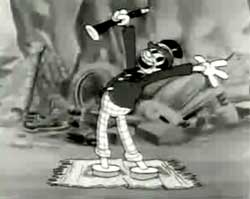 An early b/w Merrie Melodies selection, A Great Big Bunch (1932) has a collection of junk at the garbage dump spring to life & have a jivin' jam session together.
An early b/w Merrie Melodies selection, A Great Big Bunch (1932) has a collection of junk at the garbage dump spring to life & have a jivin' jam session together.
The leader of the jam is a ragtime doll that sings the title song while a pair of worn out shoes tapdance to the Mort Dixon & Harry Warren number:
"A little kiss, a little sigh/ A little when, a little why/ A little who's this, a little what this/And a great big bunch of you..."
Our talented doll does an impersnation of Maurice Chevalier to close his number, then all hell breaks loose as the garbage bounces around with music. Shortly, the doll asks, in a Ted Lewis impersonation, "Is everybody happy?" then whips out a clarinet, blowing a tune that rejuvenates a grandfather clock.
There's a toy soldier sequence before returning to the jazzy doll who cries out "Away we go on the magic carpet! Okay America!" (another Ted Lewis reference) as he takes off on a washcloth that functions as a flying carpet, landing among some music-playing junk to lead a rendition of "Happy Days are Here Again" still imitating Ted Lewis on clarinet.
Three dressmaker manikens do a Boswell Sisters take on the title song "A Great Big Bunch of You." Full of sight gags throughout, & a delightful cartoon overall, with the main song a real winner.
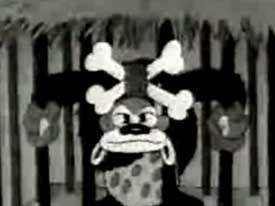 Right away we're thrown into a circus bigtop with clowns & a band parading around in the tent playing the title song I Love a Parade (1932), as an audience of animal-people sing the lyrics.
Right away we're thrown into a circus bigtop with clowns & a band parading around in the tent playing the title song I Love a Parade (1932), as an audience of animal-people sing the lyrics.
It's a parade of circus gags, very standard in type, but fun, the parade concluding with an unhappy duck with a pooper scooper.
Out in the arcade we see Jojo the wild man, a racist black stereotype of an ape-like man in leapard skin outfit & two bones through his topknot.
Gumbo the India Rubber Man is a skinny black dude with wobbly rubbery limbs, & a stereotypical blackface smile.
Also on the freak arcade are Siameze twin pigs, one smoking a cigar the other blowing the smoke; a tattooed strong man who takes a sissy pose; a hula girl hippo; & "the skinny man from India," who is Mahatma Ghandi playing an oboe.
Back in the bigtop more gag-acts are seen, fairly standard stuff for the most part, but a few original moments:
There's horse-riding hippo; a cat-girl on a highwire; mouse who bicycles around the body of a running elephant; a lion tamer whose lion gets an itchy spot on his back.
Striving to forgive the race gags, this one's a fun if generic vintage animation, it's not one of the best Merrie Melodies, & musically weak as well.
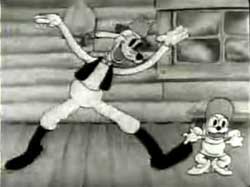 The Merrie Melodies cartoon Moonlight for Two (1932) features hillbilly dog-people, starting off with a dog on harmonica playing "She'll be Coming Round the Mountain" as a young lady dog saunters.
The Merrie Melodies cartoon Moonlight for Two (1932) features hillbilly dog-people, starting off with a dog on harmonica playing "She'll be Coming Round the Mountain" as a young lady dog saunters.
They then leap into a strange novelty number "Moonlight for Two" & dance about in the night. It's much more a jazz piece reminiscent of the Roaring Twenties ragtime, not hillbilly music.
With some excellent black & white animation, the couple adventure through some mountain-people gags to a hillbilly ho-down with donkey playing banjo & a goat on fiddle. Everyone dances to "Coming Round the Mountain."
A funny slightly gross little gag is when a billygoat fiddler uses his toe-jam for bow-rosin. A genderless pair of mules dance together finally turning their tails into a jump-rope for a girl kitty. Even the woodstove dances in the most surreal moment of the cartoon.
The ho-down band bursts into "Moonlight for Two" & our main dog dances with the animate stove when all of a sudden the party is interupted by a big villainous hick of a dog with a shotgun. This means a fight to defend the girl dog's honor, & that animate stove is still running around red-hot & burning the villain.
A particularly strange Merrie Melodies entry, not as good musically as most, but that stove becoming a major character makes it just awfully delightful.
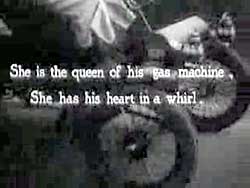 Made by special arrangement with the the auto company, the Fleischer Studio "screen songs" bouncing ball cartoon In My Merry Oldsmobile (1932) is careful not to make fun of the car.
Made by special arrangement with the the auto company, the Fleischer Studio "screen songs" bouncing ball cartoon In My Merry Oldsmobile (1932) is careful not to make fun of the car.
Lucille is a rather homely woman but a mustachioed villain takes a firm liking to her even so. He breaks into her house & begins singing to the popular tune that begins: "Come away with me, Lucile/ In my great big Oldsmobile," a weaner reference if ever there was one.
There's only one moment when Lucille seems tempted by this villain, in the "lick my candycane" sequence that is even more shocking in its overt sexual meaning. But after her over aggressive suitor finishes the song, Lucille sings a negative version of the number which insults him hugely, making him angrier & angrier, in the manner of all unwanted & jilted suitors.
While she's singing her disdain, a little tiny guy (Johnny Steele) comes by Lucille's house. This is the guy she really likes & after he finishes off the fat suitor, they leap out the window into the little guy's Oldsmobile.
With an image of a tree-lined lane sweeping by, the bouncing ball appears at first without lyrics, as a narrator gives a lecture about the auto displacing the horse. The actual lyrics of the Oldsmobile pop-song then appear under the bouncing ball: 'Young Johnny Steele has an Oldsmobile/ He loves a dear little girl/ She is the queen of his gas machine/ She has his heart in a whirl..."
Johnny Steele is later seen jumping along the words as more driving gags appear in the background. There's some quite imaginative replacements for the bouncing ball for the last minute, which spice up the cartoon considerably, while the song has historical appeal.
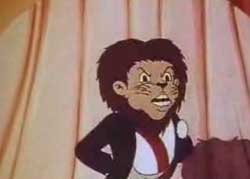 A "color classic" called A Car-Tune Classic (1937), this cartoon opens with a nostalgic throw-back to the silent Inkwell Imps cartoons that always started off with Max Fleischer's hand drawing the characters.
A "color classic" called A Car-Tune Classic (1937), this cartoon opens with a nostalgic throw-back to the silent Inkwell Imps cartoons that always started off with Max Fleischer's hand drawing the characters.
This time it's an animated hand that draws a dog in a tux with a trumpet, then a pig with a tuba, then a girl ostritch with violin, hippo with flute, lion with big main so he's the conductor, all drawn on separate sheets of paper. Last of all a theater stage is drawn & when the curtains part, the animal-band is ready to perform the Tune in Car Tune.
The lion asks the audience to put aside their prejudices about cartoon animals & to enjoy their dignified, artful performance devoid of foolery & clowning. "And now, to an all musical program."
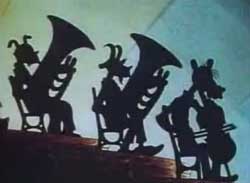 It progresses as a totally boring stodgy straightlaced classical orchestra piece. Without foolery & clowning, cartoon animals are really, really dull. It progresses as a totally boring stodgy straightlaced classical orchestra piece. Without foolery & clowning, cartoon animals are really, really dull.
Then a fly bothers the horse trumbonist, a kitty playing a horn falls asleep, & a seal attempts to be a one-man-band.
Threat of mayhem builds as the ostritch violinist shoots her violin bows like arrows, a whole bunch of monkies play a single picolo that shoots peas, & the gags come rapid fire until the stodgy lion is ripping out his mane.
It still never turned into a good cartoon, though, & even the pun of there being a Tune in the Car Tune led to false expectations of there also being a Car, an unintentional reference since there was no car.
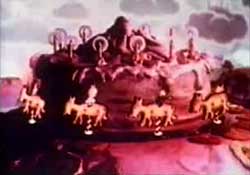 A technicolor musical Fleischer cartoon, Somewhere in Dreamland (1936) opens with two hard-working little children in rags pulling a wagon in search of scrap wood to be used no doubt to heat some pathetic hovel.
A technicolor musical Fleischer cartoon, Somewhere in Dreamland (1936) opens with two hard-working little children in rags pulling a wagon in search of scrap wood to be used no doubt to heat some pathetic hovel.
They pass a shop with a window display of pastries, & they're so excited & hungry. The fat baker goes in back to get them something but they don't know it so they continue on their way without the deserts he tried to bring them.
The various shopkeepers get together to see if they can't be helpful to those cute hard-working kids, who've arrived home to their single-mom who has nothing to feed them but chunks of hard bread. They soften the bred in water & don't complain, but it wasn't much, & they're still hungry.
The brother & sister climb into their rickety beds & sing "Somewhere in Dreamland" just before nodding off & the cheerful little bastards enter a dream together.
While a chorus sings the dreamland song, they shake nice suits of clothes loose from the clothing trees, then hurry to the ice cream garden & pluck icecream flowers in their favorite flavors. They cross Syrup River & ride a merry-go-round made of a giant birthday cake & giant animal cookies.
In the pocorn field it rains exploding corn which they catch in flower-cups. They skip along going "la la da" & arrive in the toy meadow. Finally they find the coolest set of twin beds ever & put their toys aside to jump on the beds then go to sleep.
As a variant of Little Match Girl the kids should've been found dead the next morning. But this version's lighthearted. When they wake up in their impoverished home, the neighborhood shop owners are present, having set a huge holiday dinner table for breakfast. Kind of a screwy ending to a somewhat tolerable story.
copyright © by Paghat the Ratgirl
|
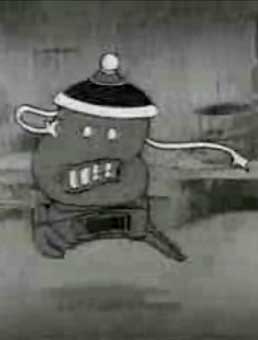





 It progresses as a totally boring stodgy straightlaced classical orchestra piece. Without foolery & clowning, cartoon animals are really, really dull.
It progresses as a totally boring stodgy straightlaced classical orchestra piece. Without foolery & clowning, cartoon animals are really, really dull.